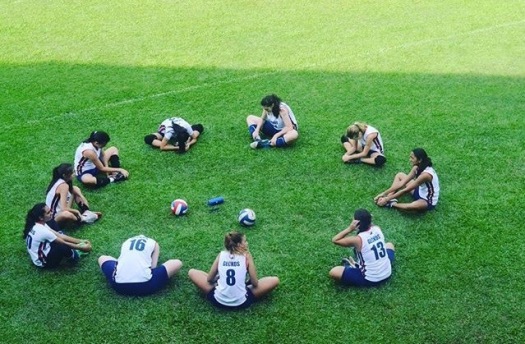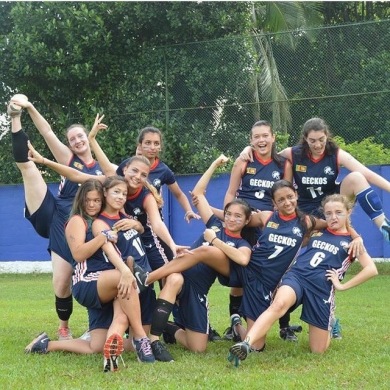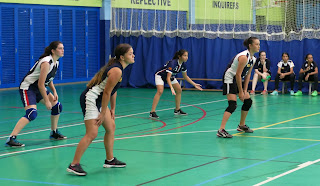Week Without Walls is a week-long school trip to somewhere on the island and – in the Diploma Programme – has a focus on one or more aspects of CAS. My trip was on the Jaffna Narratives, with the focus mainly on Service, where we get to learn more about our host island and its people, culture and history.
Jaffna is in the North of Sri Lanka and was subject to most of the Sri Lankan Civil War, which we learned a bit about as we explored the north in the aftermath of a vicious war. As we learned more and more about Sri Lanka’s history, we recorded our findings and our feelings on our findings through tweet posts. This is a map I made of the Jaffna peninsula and it highlights all the important places we visited:
Our trip was from the 26th to the 30th January 2015, and it started with an early flight to the Jaffna Airport (map position 1) up north. The first day we went to many places, including: the deepest body of water (or well) in Sri Lanka, a spiritual spring/bathhouse, Point Pedro (map position 2) – where we walked down the street near the beach and got to see the locals fishing as well as some graves from different religions – and Jaffna Fort (which was very significant in the war) near our hotel (map position 3).
Tweet of the day: “It was kind of harrowing to walk on the line between the calm sea and the site of such conflict in Jaffna Fort.”
Boarding the airplane - it was really small (Photo credit: Nisala)
The well. The locals have a story that an Indian god was travelling from India to Sri Lanka when he got thirsty, so he struck the ground with a lightning bolt and created this well. This mixture of Indian and Sri Lankan is very prominent up north (Photo credit: me)
This was the sign outside the bathhouse. I found it interesting that the warning in Tamil was shown first on the left, the Sinhalese, then English. In Colombo - the capital - the street signs usually show English first, then Sinhala, then Tamil. (Photo credit: me)
This is inside the girls' section of the bathhouse. It was really peaceful and the water came directly from the ocean, so there were fishes swimming around, and it was very relaxing. The bathrooms left a little to be desired, though (Photo credit: me)
Point Pedro! (Photo credit: me)
A Christian gravesite near the beach (Photo credit: me)
Locals fishing (or gearing up to fish - I'm not sure) (Photo credit: me)
Into the fort! (Photo credit: me)
A crumbling wall inside the fort where people have scratched their names onto the walls. That's Nisala (Photo credit: me)
That's the walkway between the fort and the ocean that I talked about in my tweet (Photo credit: me)
A close up of the map on Jaffna Town. The star on the left is Jaffna Fort and the one on the right is our hotel.
On the second day wewent on a boat trip to Nagadeepa on one of the islands around the peninsula (map position 4). We went on boat to the Buddhist religious site first then walked to the end of the street to the Kovil (a Hindu temple) and left from that jetty. The Buddhist section was very tourism centred, with an information desk and a bird cage. There also used to be a giant statue of President Rajapaksa, but it was taken down after he was replaced a few weeks before we got there. There were also very few people.
However, the Kovil was almost entirely filled up. It was very colourful inside and out, with millions of patterns and paintings (Though we weren't aloud to take pictures inside). On the wall inside there was one painting set that showed the Sri Lankan Army destroying Tamil temples and religious artefacts. Ms. Lenk later told us that it was actually the Portugese who had done that and that the painting was depicted as such for propaganda purposes.
Tweet of the day: “It’s weird how religion was used both as a weapon and a comfort in the war.”
This was the boat we went on (Photo credit: Mr. Lambert-Knott)
Inside the boat (It was really cramped) (Photo credit: me)
Outside the boat (Photo credit: me)
The Kovil (It was MASSIVE) (Photo credit: Nela)
Then we went to ice cream afterwards. Shakthi almost threw up. Good times (Photo credit: Nela)
The third day of the trip was probably my favourite. On the third day we went to visit the children at the SOS Village in Jaffna. The SOS Village is a place for children without a home or guardians due mostly due to the war. At first it was a bit awkward, especially with the age and language gaps (the majority of them were between the ages of 5 and 13, and they could only speak Tamil with a few words in English). But eventually we all relaxed and had fun together.
We originally had a set schedule for the day, but that was thrown out the window almost immediately as we let the kids decide what they wanted to do. From learning each others' names (and repeatedly making fun of mine and my pronunciation of theirs), to makeovers that started with a thorough lice check, to swinging around kids one after another until I was so dizzy that I fell down and they dog piled me, to playing netball for the first time in years (which was really incredible since it's my favourite sport), I really really enjoyed it (I might join the SOS Village service group at school next year).
Tweet of the day: “It was awesome interacting and playing with the kids despite language and age barriers”
Group photo! (Unfortunantely I forgot to take pictures that day, which I'm kind of mad about) (Photo credit: Mr. Lambert-Knott)
The fourth day we started traveling down to Trincomalee. On the way we passed many sites and memorials that were significant to the war. The most important was probably the Elephant's Pass (map position: 5), which was the site of many horrific battles, mostly because it was one of the only strips of land that connected the peninsula to the main land.
Tweet of the day (relating to the Liberation Tigers of Tamil Eelam or LTTE weapons museum we visited): “Why does war always motivate people to create amazing things but with destructive purposes?”
Memorial on the Tamil side of Elephant's Pass (Photo credit: Mr. Lambert-Knott)
Elephant's Pass (Photo credit: Mr. Lambert-Knott)
Memorial on the Sri Lankan side of Elephant's Pass. It's dedicated to a soldier who jumped with a grenade into a Tamil tank and died in the explosion. That's the tank that he jumped into on the right (Photo credit: Mr. Lambert-Knott)
This is at a LTTE weapons museum. These were some cages that people were kept in. Not sure of they were for prisoners-of-war or regular civilians but it's still pretty horrific (Photo credit: Mr. Lambert-Knott)
The entrance of the LTTE museum. All the weapons and vehicles were hand-made at home by the LTTE which is kind of amazing if you don't think about what these things were used for (Photo credit: Nela)
This is a water tank that fell over after an explosion (Photo credit: Mr. Lambert-Knott)
This is a photo of a house that suffered from bullet and shrapnel holes. It makes you wonder what happened to the occupants (Photo credit: Mr. Lambert-Knott)
This is a super deep pool made by the LTTE to practice diving in, presumably to put bombs on the bottom of ships. The sign explaining this was kind of hard to read as every second word was either "terrorist" or "evil" (Photo credit: Nela)
On the fifth day we traveled from Trinco for 6 hours straight back to Colombo. The whole trip was fun but all the things we learned about Sri Lanka were kind of awful and interesting at the same time. I hope I get to do something like it again in the future.
Group photo (Photo credit: Nisala - taken by one of the teachers)













































